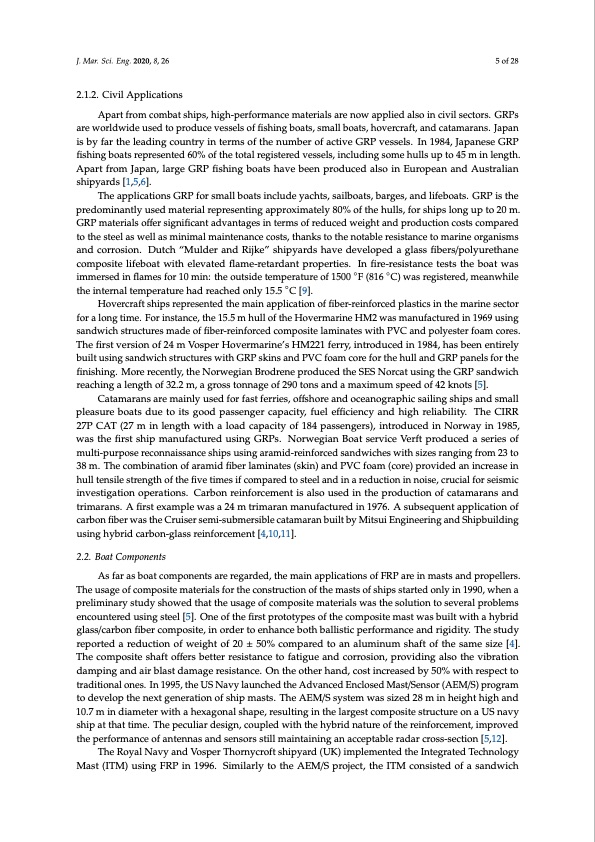
PDF Publication Title:
Text from PDF Page: 005
J. Mar. Sci. Eng. 2020, 8, 26 5 of 28 2.1.2. Civil Applications Apart from combat ships, high-performance materials are now applied also in civil sectors. GRPs are worldwide used to produce vessels of fishing boats, small boats, hovercraft, and catamarans. Japan is by far the leading country in terms of the number of active GRP vessels. In 1984, Japanese GRP fishing boats represented 60% of the total registered vessels, including some hulls up to 45 m in length. Apart from Japan, large GRP fishing boats have been produced also in European and Australian shipyards [1,5,6]. The applications GRP for small boats include yachts, sailboats, barges, and lifeboats. GRP is the predominantly used material representing approximately 80% of the hulls, for ships long up to 20 m. GRP materials offer significant advantages in terms of reduced weight and production costs compared to the steel as well as minimal maintenance costs, thanks to the notable resistance to marine organisms and corrosion. Dutch “Mulder and Rijke” shipyards have developed a glass fibers/polyurethane composite lifeboat with elevated flame-retardant properties. In fire-resistance tests the boat was immersed in flames for 10 min: the outside temperature of 1500 ◦F (816 ◦C) was registered, meanwhile the internal temperature had reached only 15.5 ◦C [9]. Hovercraft ships represented the main application of fiber-reinforced plastics in the marine sector for a long time. For instance, the 15.5 m hull of the Hovermarine HM2 was manufactured in 1969 using sandwich structures made of fiber-reinforced composite laminates with PVC and polyester foam cores. The first version of 24 m Vosper Hovermarine’s HM221 ferry, introduced in 1984, has been entirely built using sandwich structures with GRP skins and PVC foam core for the hull and GRP panels for the finishing. More recently, the Norwegian Brodrene produced the SES Norcat using the GRP sandwich reaching a length of 32.2 m, a gross tonnage of 290 tons and a maximum speed of 42 knots [5]. Catamarans are mainly used for fast ferries, offshore and oceanographic sailing ships and small pleasure boats due to its good passenger capacity, fuel efficiency and high reliability. The CIRR 27P CAT (27 m in length with a load capacity of 184 passengers), introduced in Norway in 1985, was the first ship manufactured using GRPs. Norwegian Boat service Verft produced a series of multi-purpose reconnaissance ships using aramid-reinforced sandwiches with sizes ranging from 23 to 38 m. The combination of aramid fiber laminates (skin) and PVC foam (core) provided an increase in hull tensile strength of the five times if compared to steel and in a reduction in noise, crucial for seismic investigation operations. Carbon reinforcement is also used in the production of catamarans and trimarans. A first example was a 24 m trimaran manufactured in 1976. A subsequent application of carbon fiber was the Cruiser semi-submersible catamaran built by Mitsui Engineering and Shipbuilding using hybrid carbon-glass reinforcement [4,10,11]. 2.2. Boat Components As far as boat components are regarded, the main applications of FRP are in masts and propellers. The usage of composite materials for the construction of the masts of ships started only in 1990, when a preliminary study showed that the usage of composite materials was the solution to several problems encountered using steel [5]. One of the first prototypes of the composite mast was built with a hybrid glass/carbon fiber composite, in order to enhance both ballistic performance and rigidity. The study reported a reduction of weight of 20 ± 50% compared to an aluminum shaft of the same size [4]. The composite shaft offers better resistance to fatigue and corrosion, providing also the vibration damping and air blast damage resistance. On the other hand, cost increased by 50% with respect to traditional ones. In 1995, the US Navy launched the Advanced Enclosed Mast/Sensor (AEM/S) program to develop the next generation of ship masts. The AEM/S system was sized 28 m in height high and 10.7 m in diameter with a hexagonal shape, resulting in the largest composite structure on a US navy ship at that time. The peculiar design, coupled with the hybrid nature of the reinforcement, improved the performance of antennas and sensors still maintaining an acceptable radar cross-section [5,12]. The Royal Navy and Vosper Thornycroft shipyard (UK) implemented the Integrated Technology Mast (ITM) using FRP in 1996. Similarly to the AEM/S project, the ITM consisted of a sandwichPDF Image | Marine Application of Fiber Reinforced Composites

PDF Search Title:
Marine Application of Fiber Reinforced CompositesOriginal File Name Searched:
jmse-08-00026.pdfDIY PDF Search: Google It | Yahoo | Bing
Development of a solar powered Electric Ship The Electricship website originally started off as a project to develop a comprehensive renewable, affordable, modular electric ship... More Info
Modular Boat Hull Composite The case for a unsinkable, modular composite hybrid boat hull... More Info
MS Burgenstock Hybrid Electric Catamaran Lake Lucerne Unique shuttle servicing Lucerne to the Burgenstock Resort... More Info
Ground Power Unit GPU Powered by Lithium Ion Batteries The goal of the Ground Power Unit is to provide a readily accessible, modular, ready-to-power solution for remote power... More Info
| CONTACT TEL: 608-238-6001 Email: greg@electricship.com | RSS | AMP |